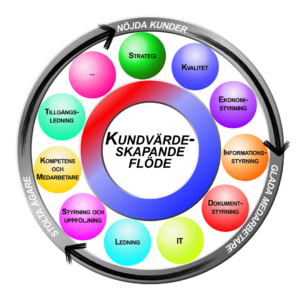
We continue with the list of the six questions you need crystal clear answers to in order to have a good business:
- Why and for whom do you exist?
- What does this “who” need and want?
- What do you need to do to meet these needs and desires?
- How will you do this work?
- What tools do we need to do this work?
- What skills are needed to do this work?
Up to today’s question, the fifth in the order, you will have gained a lot of clarity about your business if you have answered the questions so far. You know why you exist and for whom. You further know WHAT it is you need to do to satisfy the one you exist for and their needs and desires. And furthermore HOW you do it by supporting those who will deliver the value.
What tools do we need to do this work?
Then it’s time to look at the tools that those who will be doing the work need.
In our increasingly digital world, tools are often different types of business systems, which I thought I would focus on in this weekly newsletter. Of course, there may be other types of tools as well, such as vehicles of various kinds. These are also important to identify and describe.
But here we are looking at business systems, that is, computer programs in some form.
The wrong focus gives the wrong tools
Too many have acquired business systems based on the domain they work in. So the economists have an accounting system, the HR people have an HR system, production has a production system, and so on.
Many times, this means that the systems are purchased based on the introverted focus of these departments, forgetting that the data and functions that these systems include actually affect others as well.
What others? Well, the others who are in the value-creating flows where the above-mentioned departments happen to be.
For example, it is not uncommon for the financial system to be designed for economists only, with only the finance department having access to the system. You don’t let others in from the rest of the business, although there are many who are interested in the financial situation. Instead, controllers are often used as the interface between the finance department and the rest of the business.
There are similar examples from other departments where there is no openness to others in the business other than oneself within “our department”.
The requirements will be wrong
Unfortunately, this means that there is a mismatch between the structure of the information/data contained in the system and the functionality needed to support the business.
There is a lack of information, a lack of functionality and, above all, a lack of open interfaces to ‘talk’ to other systems. The systems are more like isolated islands where only certain people are allowed to stay if they belong to the right department.
The demands become all wrong when you don’t have the right focus in your business.
The right focus gives the right system
What is needed is an understanding that everything starts from the value-creating flows. It is the value-creating flows that demand which tools are needed in the business.
We at Clean Stream illustrate this with the picture of the coal bed below. In my book A Little Like the Dalai Lama for Organizations, which you may have read, the symbol of a flower is supposed to show the same thing. However, we have upgraded to a ball bearing instead, as we see that it helps show how everything in a business revolves around the value-creating flows. Not that documents are the focus, or IT support, or the economy, or any of the other important areas.
They are all based on the needs and requirements of the value-creating flows.

To make
So what you need to do is, based on the answers you got in questions 1 to 3 in the list above, be able to see your value creation flows, and from there set requirements on how you want your processes to look like and then in “today’s question” be able to specify exactly what you want your systems to be able to support with.
Vendors will have a very different and much more detailed picture of what you want their systems to do. They will have to relate to you and your requirements, not the other way around; where they sell their smart features to you and you have to adapt.
Start with a process, review its detailed flow, and then determine its business support needs.
Some of these requirements may not exist today, because your system does not have these features. Then it must be solved in another way. Other requirements will be met with the system support you have. While others should be solved in the existing business systems, which you will have to ask your system provider for.
Do you have system suppliers who have built their systems in a modular way and they themselves have a flexible organisation. Then they should be able to satisfy your needs in the near future.
Ends here. Next Sunday I’ll write about skills needs.
If you’re interested in checking out our training courses until then, visit www.cleanstream.se/utbildningar and you can read more there.
We will soon be releasing a new online training course on how to use BPMN – Business Process Modeling and Notation – which is a world standard in how to describe your processes. It is called BPMN – Basics. Check out the link.
Greetings,
Matts

